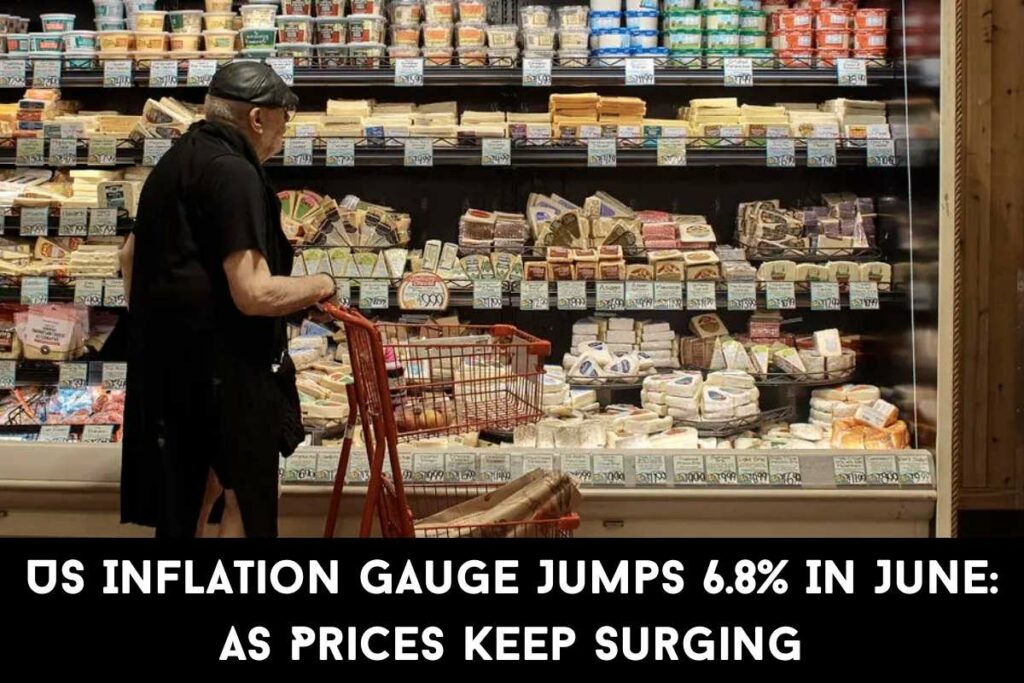The Federal Reserve monitors inflation, which increased 6.8 percent in June from a year earlier, marking the largest increase in four decades and leaving Americans with no reprieve from rising prices.
The Commerce Department’s data released on Friday highlighted how persistent inflation is, reducing Americans’ purchasing power, lowering their confidence in the economy, and endangering Democrats in Congress as the November midterm elections approach.
Prices increased 1% from May to June every month, the fastest increase since 2005 and quicker than the 0.6 % increase from April to May. According to government statistics, consumer expenditure increased by 0.1 percent from May to June after accounting for price adjustments, just managing to keep up with inflation. In the face of high inflation, consumer spending has decreased.
Also have a look at
- WWE 2K23 Release Date for PC, PS4, PS5, Xbox One 2022
- Rapper JayDaYoungan Shot Dead In Bogalusa: Shot And Killed In Home Town
But it’s also contributing to inflation itself, as demand is still high for a variety of goods and services, including airline tickets, hotel rooms, restaurant meals, and both new and used cars. Even though many workers have received salary hikes, most consumers lag behind the cost-of-living expenses rate.
Since inflation has been rising so quickly, the U.S. economy, which contracted in the April-June quarter for a second consecutive quarter, fueling concerns that a recession is imminent, is also being hampered by high inflation and interest rates. An unofficial rule of thumb states that a recession starts after two consecutive quarters of declining growth, yet strong hiring signals that the economy still has pockets of resilience and isn’t yet in a downturn.
BREAKING: An inflation gauge that is closely tracked by the Federal Reserve jumped 6.8% in June from a year ago, the biggest increase in four decades, and leaving Americans with no relief from surging costs. https://t.co/WQnVCE5ZdB
— The Associated Press (@AP) July 29, 2022
In its most aggressive effort to control excessive inflation over three decades, the Fed hiked its benchmark interest rate by three-quarters of a percent on Wednesday. Jerome Powell, the Fed’s chair, hinted that the rate increases would slow down in the coming months. Mr. Powell emphasized that the Fed’s decision-makers prioritize fighting inflation as their top priority.
He made no indication that if inflation stayed high, a slowing economy would lead the Fed to scale back or reverse its rate hikes this year or early next year. The Fed increases borrowing costs, making it more expensive to get a mortgage, vehicle, or business loan. The objective is for firms and people to borrow, spend, and hire less, which will halt inflation and cool the economy.
Even after accounting for inflation, consumer spending did rise during the January-March quarter. However, the statistic represented a pitiful 1 percent annual rise, down from 1.8 percent in the period between January and March. At the same time, the housing market has been hurt by significantly rising mortgage rates: Five consecutive months of declining existing house sales have contributed to the economy’s downturn in the April-June quarter. President Joe Biden denied any claims that a recession had started on Thursday.
Mr. Biden cited continued strong job creation, an unemployment rate close to a half-century low, and a wave of semiconductor company investments as indicators that the economy is still strong. Mr. Biden also applauded a compromise reached by Senate Democrats on a scaled-back version of his Build Back Better legislation, which many economists believe has the potential to gradually reduce inflation.
By lowering total demand, the law would reduce the government’s budget deficit, which controls inflation. By allowing Medicare to bargain for lower prescription prices, it would also cut seniors’ costs. Rising inflation was a result of the economy’s quick recovery from the pandemic recession of 2020 across the board.
Factory, port, and freight yard capacity was exceeded by government-fueled demand brought on by massive stimulus funding, record-low borrowing rates, and consumer savings amassed during the pandemic. Prices rose due to the consequent shortages of both products and labour. The conflict between Russia and Ukraine raised the price of gasoline, food, fertiliser, and other products worldwide.
The Federal Reserve often keeps a closer eye on Friday’s inflation indicator, known as the personal consumption expenditures price index, than it does the government’s more well-known consumer price index. The CPI earlier this month recorded an acceleration in inflation, with a June year-over-year change of 9.1 percent, representing the highest level in 41 years.
The PCE index, a broader measure of inflation that includes payments made on behalf of consumers, such as medical services covered by insurance or government programmes, tends to reflect a lower inflation level than the CPI. The CPI covers only out-of-pocket expenses, which have increased more recently.
Also have a look at
- Economists Weigh In On Whether Recession Is Looming: ‘Ugly’ Inflation Numbers Make A Recession
- Exxon, Chevron Post Record Profits: Oil Companies Reap Unprecedented Profits
Rents are likewise given less weight in the PCE than in the CPI, although climbing at their quickest rate in 35 years. The PCE price index aims to take into account adjustments in consumer behaviour brought on by increases in inflation. It can, therefore, record, when customers transfer from expensive national brands to less expensive retail brands.
For more articles like this stay tuned with newsconduct.com

